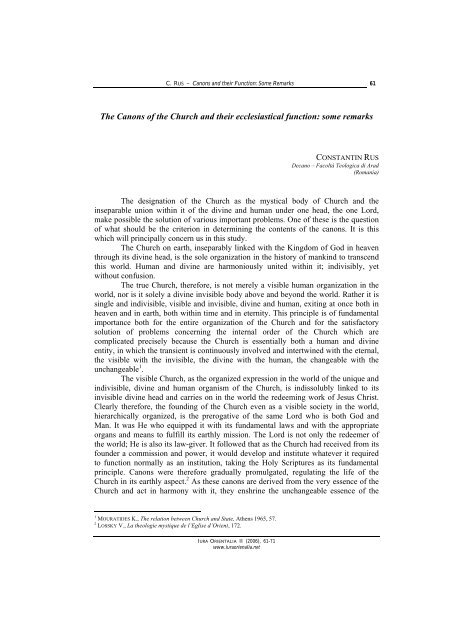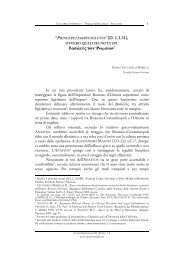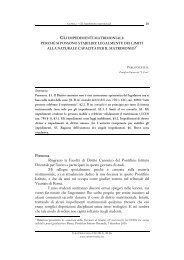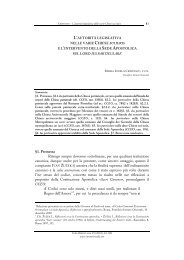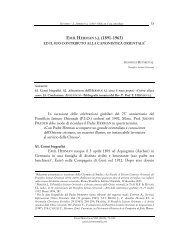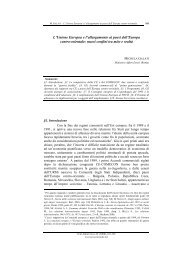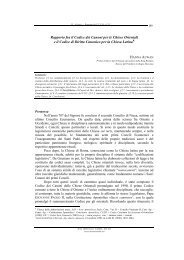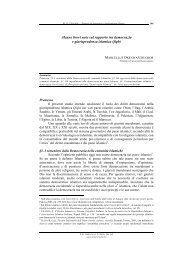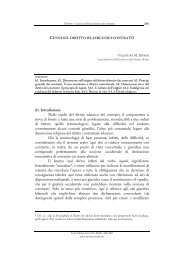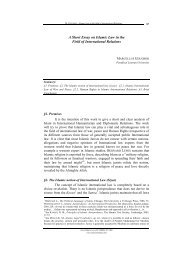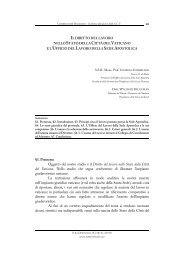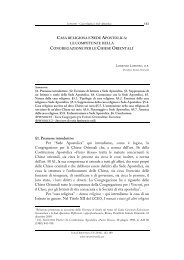The Canons of the Church and their ecclesiastical ... - iura orientalia
The Canons of the Church and their ecclesiastical ... - iura orientalia
The Canons of the Church and their ecclesiastical ... - iura orientalia
Create successful ePaper yourself
Turn your PDF publications into a flip-book with our unique Google optimized e-Paper software.
C. RUS – <strong>Canons</strong> <strong>and</strong> <strong>the</strong>ir Function: Some Remarks61<strong>The</strong> <strong>Canons</strong> <strong>of</strong> <strong>the</strong> <strong>Church</strong> <strong>and</strong> <strong>the</strong>ir <strong>ecclesiastical</strong> function: some remarksCONSTANTIN RUSDecano – Facoltà Teologica di Arad(Romania)<strong>The</strong> designation <strong>of</strong> <strong>the</strong> <strong>Church</strong> as <strong>the</strong> mystical body <strong>of</strong> <strong>Church</strong> <strong>and</strong> <strong>the</strong>inseparable union within it <strong>of</strong> <strong>the</strong> divine <strong>and</strong> human under one head, <strong>the</strong> one Lord,make possible <strong>the</strong> solution <strong>of</strong> various important problems. One <strong>of</strong> <strong>the</strong>se is <strong>the</strong> question<strong>of</strong> what should be <strong>the</strong> criterion in determining <strong>the</strong> contents <strong>of</strong> <strong>the</strong> canons. It is thiswhich will principally concern us in this study.<strong>The</strong> <strong>Church</strong> on earth, inseparably linked with <strong>the</strong> Kingdom <strong>of</strong> God in heaventhrough its divine head, is <strong>the</strong> sole organization in <strong>the</strong> history <strong>of</strong> mankind to transcendthis world. Human <strong>and</strong> divine are harmoniously united within it; indivisibly, yetwithout confusion.<strong>The</strong> true <strong>Church</strong>, <strong>the</strong>refore, is not merely a visible human organization in <strong>the</strong>world, nor is it solely a divine invisible body above <strong>and</strong> beyond <strong>the</strong> world. Ra<strong>the</strong>r it issingle <strong>and</strong> indivisible, visible <strong>and</strong> invisible, divine <strong>and</strong> human, exiting at once both inheaven <strong>and</strong> in earth, both within time <strong>and</strong> in eternity. This principle is <strong>of</strong> fundamentalimportance both for <strong>the</strong> entire organization <strong>of</strong> <strong>the</strong> <strong>Church</strong> <strong>and</strong> for <strong>the</strong> satisfactorysolution <strong>of</strong> problems concerning <strong>the</strong> internal order <strong>of</strong> <strong>the</strong> <strong>Church</strong> which arecomplicated precisely because <strong>the</strong> <strong>Church</strong> is essentially both a human <strong>and</strong> divineentity, in which <strong>the</strong> transient is continuously involved <strong>and</strong> intertwined with <strong>the</strong> eternal,<strong>the</strong> visible with <strong>the</strong> invisible, <strong>the</strong> divine with <strong>the</strong> human, <strong>the</strong> changeable with <strong>the</strong>unchangeable 1 .<strong>The</strong> visible <strong>Church</strong>, as <strong>the</strong> organized expression in <strong>the</strong> world <strong>of</strong> <strong>the</strong> unique <strong>and</strong>indivisible, divine <strong>and</strong> human organism <strong>of</strong> <strong>the</strong> <strong>Church</strong>, is indissolubly linked to itsinvisible divine head <strong>and</strong> carries on in <strong>the</strong> world <strong>the</strong> redeeming work <strong>of</strong> Jesus Christ.Clearly <strong>the</strong>refore, <strong>the</strong> founding <strong>of</strong> <strong>the</strong> <strong>Church</strong> even as a visible society in <strong>the</strong> world,hierarchically organized, is <strong>the</strong> prerogative <strong>of</strong> <strong>the</strong> same Lord who is both God <strong>and</strong>Man. It was He who equipped it with its fundamental laws <strong>and</strong> with <strong>the</strong> appropriateorgans <strong>and</strong> means to fulfill its earthly mission. <strong>The</strong> Lord is not only <strong>the</strong> redeemer <strong>of</strong><strong>the</strong> world; He is also its law-giver. It followed that as <strong>the</strong> <strong>Church</strong> had received from itsfounder a commission <strong>and</strong> power, it would develop <strong>and</strong> institute whatever it requiredto function normally as an institution, taking <strong>the</strong> Holy Scriptures as its fundamentalprinciple. <strong>Canons</strong> were <strong>the</strong>refore gradually promulgated, regulating <strong>the</strong> life <strong>of</strong> <strong>the</strong><strong>Church</strong> in its earthly aspect. 2 As <strong>the</strong>se canons are derived from <strong>the</strong> very essence <strong>of</strong> <strong>the</strong><strong>Church</strong> <strong>and</strong> act in harmony with it, <strong>the</strong>y enshrine <strong>the</strong> unchangeable essence <strong>of</strong> <strong>the</strong>1 MOURATIDES K., <strong>The</strong> relation between <strong>Church</strong> <strong>and</strong> State, A<strong>the</strong>ns 1965, 57.2 LOSSKY V., La <strong>the</strong>ologie mystique de l’Eglise d’Orient, 172.IURA ORIENTALIA II (2006), 61-71www.<strong>iura</strong>orienalia.net
C. RUS – <strong>Canons</strong> <strong>and</strong> <strong>the</strong>ir Function: Some Remarks62<strong>Church</strong> in <strong>the</strong> changing conditions <strong>of</strong> history 3 <strong>and</strong> are eternal, visible, historical <strong>and</strong>changeable expression <strong>of</strong> <strong>the</strong> unchangeable element, <strong>the</strong> doctrines <strong>of</strong> <strong>the</strong> faith; 4 hence<strong>the</strong> close, direct <strong>and</strong> essential relation between dogma <strong>and</strong> canons. It is for this reasonthat <strong>the</strong> Greek words dovgma <strong>and</strong> kavnwn are sometimes used as synonyms 5 .Such an expression <strong>of</strong> <strong>the</strong> essence <strong>of</strong> <strong>the</strong> <strong>Church</strong> necessarily rests on concretehistorical premises <strong>and</strong> preconditions. Since <strong>the</strong> historical conditions under which <strong>the</strong><strong>Church</strong> has been called on occasion to fulfill its saving mission have not remainedstable or unchanged, <strong>the</strong> life <strong>of</strong> <strong>the</strong> <strong>Church</strong> <strong>and</strong> <strong>the</strong> <strong>ecclesiastical</strong> laws which govern ithave developed parallel with <strong>the</strong> change <strong>and</strong> development in <strong>the</strong> external conditions.<strong>The</strong> canons were not all promulgated at once, but gradually, as <strong>the</strong> new religion spreadabroad, <strong>and</strong> various external factors dem<strong>and</strong>ed that <strong>the</strong> Christian <strong>Church</strong> be organizedby explicit regulations 6 .This gradual promulgation <strong>of</strong> <strong>the</strong> canons, linked to <strong>the</strong> Christian communities’periodic needs which <strong>the</strong> <strong>Church</strong> attempted to meet with its laws, has led certainOrthodox <strong>the</strong>ologians to argue as follows: lying behind <strong>the</strong> canons are <strong>the</strong> <strong>Church</strong>’sextensive <strong>and</strong> varied interest leading it to give its children a guide-line to enable <strong>the</strong>mto identity basic questions soundly <strong>and</strong> to deal with <strong>the</strong>m correctly 7 ; fur<strong>the</strong>r, <strong>the</strong> needs<strong>of</strong> its children have altered in much <strong>and</strong> are continually altering, alongside <strong>the</strong>circumstances <strong>of</strong> society <strong>and</strong> <strong>the</strong> effect <strong>of</strong> <strong>the</strong> passage <strong>of</strong> time <strong>and</strong> <strong>of</strong> modernconceptions. It is consequently self-evident that <strong>the</strong> <strong>Church</strong> not only can but mustadapt its laws to <strong>the</strong>se new needs, by modifying or even abolishing canons that havecome to be useless or impractical, <strong>and</strong> must promulgate new ones as <strong>the</strong>y becomenecessary 8 .<strong>The</strong>re are also <strong>the</strong> extreme liberals who unhesitatingly regard any discussionwhatever about <strong>the</strong> canons as completely useless, sterile <strong>and</strong> casuistically, as revolvingaround laws which, if <strong>the</strong>y are not dead, are certainly well on <strong>the</strong> way to <strong>the</strong> grave.As well as <strong>the</strong> conservative progressives <strong>and</strong> <strong>the</strong> extreme liberals, <strong>the</strong>re are <strong>the</strong>extreme conservatives: those who reject any possibility <strong>of</strong> change or modification in<strong>the</strong> canons. <strong>The</strong>y rely chiefly on canon two <strong>of</strong> <strong>the</strong> Council in Trullo 9 , which ratified <strong>the</strong>canonical code prevailing previously, <strong>and</strong> secondarily on <strong>the</strong> first canon <strong>of</strong> <strong>the</strong> seventhEcumenical Council (Nicaea II) 10 , which, having no reason to go into a detailed3 PETROVIC M., <strong>The</strong> Nomocanon in 14 titles <strong>and</strong> <strong>the</strong> Byzantine commentators, A<strong>the</strong>ns 1970, 68.4 EVDOKIMOV P., L’Orthodoxie, Paris-Neuchâtel 1959, 39.5 STEPHANIDES B., <strong>The</strong> bounds <strong>of</strong> <strong>the</strong> <strong>ecclesiastical</strong> legislation <strong>of</strong> <strong>the</strong> Byzantine Emperors, A<strong>the</strong>ns 1995, 13.6 ARCHONTONES V., On <strong>the</strong> codification <strong>of</strong> <strong>the</strong> sacred canons <strong>and</strong> <strong>the</strong> canonical institutions in <strong>the</strong> Orthodox <strong>Church</strong>,<strong>The</strong>ssaloniki 1970, 17-18.7 ÆMILIANOS (Bishop <strong>of</strong> Meloa), <strong>The</strong> <strong>Church</strong> <strong>of</strong> <strong>the</strong> canons, A<strong>the</strong>ns 1963, 51.8 ARCHONTONES V., op. cit., 19.9 RHALLES G. – POTLES M., Suvntagma t§n qeh=wn kaiV èer§n kanünwn, A<strong>the</strong>nai 1852, vol. II, 308-310. <strong>The</strong> canon readsas follows: «It seemed very good <strong>and</strong> proper to <strong>the</strong> holy council that <strong>the</strong> 85 canons accepted <strong>and</strong> ratified by <strong>the</strong> holy <strong>and</strong>blessed fa<strong>the</strong>rs before us <strong>and</strong> h<strong>and</strong>ed down to us in <strong>the</strong> name <strong>of</strong> <strong>the</strong> holy <strong>and</strong> glorious Apostles should continue fromnow on secure <strong>and</strong> certain for <strong>the</strong> cure <strong>of</strong> souls <strong>and</strong> <strong>the</strong> healing <strong>of</strong> passions … <strong>and</strong> we set our seal also upon <strong>the</strong> o<strong>the</strong>rholy canons promulgated by our holy <strong>and</strong> blessed fa<strong>the</strong>rs (<strong>the</strong>re follows a list <strong>of</strong> <strong>the</strong> councils <strong>the</strong> canons <strong>of</strong> which areratified) … Nobody is permitted to falsify <strong>the</strong> afore-mentioned canons or to set <strong>the</strong>m aside, or to accept, besides thosementioned, o<strong>the</strong>r canons spuriously added to <strong>the</strong> o<strong>the</strong>rs by people attempting to debase <strong>the</strong> truth. If someone is caughtinnovating or attempting to overthrow one <strong>of</strong> <strong>the</strong>se canons, he shall be liable to receive <strong>the</strong> punishment laid down by <strong>the</strong>canon, <strong>and</strong> shall thus be corrected in his fault».10 Ibidem.IURA ORIENTALIA II (2006), 61-71www.<strong>iura</strong>orienalia.net
C. RUS – <strong>Canons</strong> <strong>and</strong> <strong>the</strong>ir Function: Some Remarks63enumeration <strong>of</strong> <strong>the</strong> canonical <strong>and</strong> doctrinal resolutions <strong>of</strong> <strong>the</strong> earlier councils <strong>and</strong><strong>Church</strong> Fa<strong>the</strong>rs, merely reiterated more precisely <strong>and</strong> clearly what <strong>the</strong> Council inTrullo had promulgated on <strong>the</strong> code <strong>of</strong> <strong>the</strong> ancient canons <strong>and</strong> <strong>the</strong>ir authority: «To<strong>the</strong>se <strong>the</strong>re is to be no adding, <strong>and</strong> from <strong>the</strong>m <strong>the</strong>re is to be no taking away» 11 .Yet what is <strong>the</strong> exact meaning <strong>of</strong> <strong>the</strong>se canons? CHRISTODOULOS’ commentaryon <strong>the</strong>se two canons is extremely interesting: «<strong>The</strong> wording <strong>of</strong> this canon (two <strong>of</strong>Trullo) does not concern itself with <strong>the</strong> <strong>Church</strong>’s legislative power to change or ratify<strong>the</strong> canons. In <strong>the</strong> original words <strong>of</strong> <strong>the</strong> canon, <strong>the</strong> council ratifies <strong>the</strong> canonical codeas it had taken shape by <strong>the</strong> end <strong>of</strong> <strong>the</strong> seventh century <strong>and</strong>, by accepting it, confirms<strong>the</strong> councils <strong>and</strong> canons <strong>of</strong> <strong>the</strong> Fa<strong>the</strong>rs which it enumerates by name. Finally itprohibits any falsification or adulteration in <strong>the</strong> code as ratified, or replacement <strong>of</strong> <strong>the</strong>canons recognized by <strong>the</strong> <strong>Church</strong> with spuria written by unscrupulous persons. <strong>The</strong>prohibition by <strong>the</strong> council <strong>of</strong> any such activity was necessary when <strong>the</strong> canonical codewas being specifically ratified for <strong>the</strong> first time by <strong>the</strong> legislative power <strong>and</strong> is directedat people who attempt to exploit <strong>the</strong> truth, <strong>and</strong> not at <strong>the</strong> acts <strong>of</strong> <strong>the</strong> legal power in <strong>the</strong><strong>Church</strong>. If we compare <strong>the</strong> phrasing <strong>of</strong> <strong>the</strong> second canon with that <strong>of</strong> <strong>the</strong> first, whichdoes speak about <strong>the</strong> untouchables <strong>and</strong> exchangeability <strong>of</strong> <strong>the</strong> dogmatic definitions <strong>of</strong><strong>the</strong> Ecumenical Councils, <strong>the</strong>n <strong>the</strong> distinction made by <strong>the</strong> councils between <strong>the</strong> twobecomes clear. <strong>The</strong> council summarized <strong>the</strong> truths <strong>of</strong> <strong>the</strong> faith defined <strong>and</strong> clarified in<strong>the</strong> creeds <strong>and</strong> dogmas <strong>of</strong> <strong>the</strong> six Ecumenical Councils, decreeing at <strong>the</strong> end <strong>of</strong> <strong>the</strong> firstcanon: «<strong>The</strong> faith <strong>of</strong> all <strong>the</strong> men who have been prominent in <strong>the</strong> <strong>Church</strong> <strong>of</strong> God is tohold fast <strong>and</strong> continue until <strong>the</strong> consummation <strong>of</strong> <strong>the</strong> world, (…) for we have resolvedabsolutely nei<strong>the</strong>r to add anything nor to take anything away from what has beendecreed before in any possible way». Similarly, <strong>the</strong>re is an important distinctionbetween <strong>the</strong> penalties <strong>the</strong> council imposes for transgressing <strong>the</strong> first <strong>and</strong> secondcanons. In <strong>the</strong> second canon, anyone convicted <strong>of</strong> innovating or <strong>of</strong> attempting tooverthrow any <strong>of</strong> <strong>the</strong> canons afore-mentioned by <strong>the</strong> council is declared liable toreceive <strong>the</strong> punishment fixed by <strong>the</strong> canon he has perverted or changed. In <strong>the</strong> firstcanon, we read: «And if anybody does not keep <strong>and</strong> cleave to <strong>the</strong> afore-mentioneddogmas <strong>of</strong> <strong>the</strong> faith <strong>and</strong> thus glorify <strong>and</strong> preach <strong>the</strong>m abroad, but attempts on <strong>the</strong>contrary to overthrow <strong>the</strong>m, let him be ana<strong>the</strong>ma (…) <strong>and</strong> let him be expelled <strong>and</strong>banished from <strong>the</strong> Christian register as an alien». <strong>The</strong> 2 nd canon <strong>of</strong> <strong>the</strong> Council inTrullo thus contains no suggestion that <strong>the</strong> canonical <strong>and</strong> disciplinary regulations <strong>of</strong> <strong>the</strong>canonical code are unchangeable <strong>and</strong> immovable, still less that this immovability mustbe understood in <strong>the</strong> same sense as that <strong>of</strong> <strong>the</strong> Holy Scriptures. Nor does <strong>the</strong> councilput <strong>the</strong> canonical ordinances <strong>of</strong> <strong>the</strong> preceding councils on a par in importance forChristians with <strong>the</strong>ir dogmatic definitions. <strong>The</strong> direct sense <strong>of</strong> <strong>the</strong> words <strong>of</strong> <strong>the</strong> canonis to forbid any Christian, whatever his position in <strong>the</strong> <strong>Church</strong>, to change, pervert,replace or adulterate <strong>the</strong> canons on his own authority. <strong>The</strong>re is absolutely no mentionin <strong>the</strong> canon <strong>of</strong> acts <strong>of</strong> <strong>the</strong> legislative power <strong>of</strong> <strong>the</strong> <strong>Church</strong>, or <strong>of</strong> its prerogatives todevelop <strong>and</strong> change earlier laws. <strong>The</strong> same sense is expressed in <strong>the</strong> first canon <strong>of</strong>Nicaea II. On <strong>the</strong> o<strong>the</strong>r h<strong>and</strong> many <strong>of</strong> <strong>the</strong> councils employ <strong>the</strong> word ananeoumeqa (“we11 RHALLES G. – POTLES M., op. cit., II, p. 555-556.IURA ORIENTALIA II (2006), 61-71www.<strong>iura</strong>orienalia.net
C. RUS – <strong>Canons</strong> <strong>and</strong> <strong>the</strong>ir Function: Some Remarks64renew”); such an expression would not have been used if <strong>the</strong> keeping <strong>of</strong> <strong>the</strong> canonswere as immovable as <strong>the</strong> doctrines <strong>of</strong> <strong>the</strong> faith. Again, <strong>the</strong> Council in Trullo firstratifies in general <strong>the</strong> canons <strong>of</strong> <strong>the</strong> local councils, <strong>and</strong> <strong>the</strong>n goes to correct <strong>and</strong> even torepeal some it regarded as resting on erroneous foundations (compare canon fifteen <strong>of</strong>Neocaesarea with sixteen <strong>of</strong> Trullo). <strong>The</strong> seventh Ecumenical Council, although sayingin its first canon that “we preserve everything that has been h<strong>and</strong>ed down,”never<strong>the</strong>less adds ano<strong>the</strong>r twenty two canons, some <strong>of</strong> which repeat earlier canons thatwere apparently no longer in force. <strong>The</strong> same council in its first canon quotes Moses,by saying: «You shall not add anything to <strong>the</strong>se things, nor shall you take anythingaway», yet it still introduces ano<strong>the</strong>r twenty two canons. We are all familiar with <strong>the</strong>remarks <strong>of</strong> <strong>the</strong> ancient canonists that such-<strong>and</strong>-such a canon was valid, or was nolonger in force, that it was universal or particular. BALSAMON says in hisinterpretation <strong>of</strong> <strong>the</strong> fifty-ninth canon <strong>of</strong> <strong>the</strong> Council in Trullo that <strong>the</strong> provisions <strong>of</strong> <strong>the</strong>canon were not in force, but ra<strong>the</strong>r those <strong>of</strong> <strong>the</strong> Novel <strong>of</strong> LEO THE WISE prevailed (seealso his Commentary, XVI, 1, 2). From <strong>the</strong> general spirit <strong>of</strong> <strong>the</strong> council’s phrasing, iremerges that <strong>the</strong> ancient canons are recognized <strong>and</strong> ratified as m<strong>and</strong>atory law for <strong>the</strong>whole <strong>Church</strong> <strong>and</strong> for every individual member <strong>of</strong> it. None <strong>of</strong> <strong>the</strong> members is justifiedin perverting <strong>the</strong>m, in replacing tem with o<strong>the</strong>rs, or in introducing completely newelements into <strong>the</strong>m on his own initiative 12 .This disagreement <strong>and</strong> controversy amongst <strong>the</strong> canonists is clearly to beattributed to a different <strong>the</strong>ological conception <strong>of</strong> <strong>the</strong> sense <strong>and</strong> purpose <strong>of</strong> <strong>the</strong> canons.According with SCHMEMANN, <strong>the</strong> gravest error <strong>of</strong> <strong>the</strong> extreme liberals lies in <strong>the</strong>irseeing <strong>the</strong> canons as having <strong>the</strong> characteristics <strong>of</strong> secular laws, as administrativedecrees which are automatically changed, if only <strong>the</strong> appropriate text can be found. Yetit is here that <strong>the</strong> problem lies, in that a canon is not purely a legal text or principlewith no practical application in <strong>the</strong> <strong>Church</strong> whatsoever. A canon is a demonstration <strong>of</strong><strong>the</strong> way in which, in a given situation, <strong>the</strong> eternal unchangeable essence <strong>of</strong> <strong>the</strong> <strong>Church</strong>must be revised <strong>and</strong> expressed. This eternal truth expressed in a particular canon,promulgated on a specific historical occasion in conditions probably differing radicallyfrom those pertaining today, remains stable <strong>and</strong> everlasting in <strong>the</strong> canons, making <strong>the</strong>man unchangeable part <strong>of</strong> church tradition. <strong>The</strong>re are various forms <strong>of</strong> <strong>the</strong> historicalessence <strong>of</strong> <strong>the</strong> <strong>Church</strong> for each person who has even a slight acquaintance with itshistory; <strong>the</strong>re is clearly no doubt about this. In <strong>the</strong> course <strong>of</strong> history, one form replacesano<strong>the</strong>r. However, in all <strong>the</strong> various different forms <strong>of</strong> <strong>the</strong> life <strong>of</strong> <strong>the</strong> <strong>Church</strong>, <strong>the</strong>re is astable <strong>and</strong> permanent kernel: <strong>the</strong> dogmatic teaching on <strong>the</strong> <strong>Church</strong>, or, in o<strong>the</strong>r words,<strong>the</strong> <strong>Church</strong> itself. <strong>The</strong> life <strong>of</strong> <strong>the</strong> <strong>Church</strong> cannot take optional forms at will, but onlysuch as correspond with <strong>the</strong> essence <strong>of</strong> <strong>the</strong> <strong>Church</strong> <strong>and</strong> are able to express this essencein given historical circumstances. Thus <strong>the</strong> canons are <strong>the</strong> form in which <strong>the</strong>12 CHRISTODOULOS A., <strong>The</strong> Treatise <strong>of</strong> Canon Law, p. 57-60. A similar view on <strong>the</strong> interpretation <strong>of</strong> <strong>the</strong> 7 th canon <strong>of</strong> <strong>the</strong>Council in Trullo is held by SESAN V., Revision der Canonen und <strong>and</strong>erer kirchlichen Normen, sowie derenKodifizierung, in Proces-verbaux du premier Congres de <strong>the</strong>ologie orthodoxe a A<strong>the</strong>nes 1939, 310-323. Cfr.ARCHONTONES V., op. cit., 20. <strong>The</strong>re are scholars who believe that <strong>the</strong> said canons, even though <strong>the</strong>y did not find <strong>the</strong>irfull application throughout <strong>the</strong> long life <strong>of</strong> <strong>the</strong> <strong>Church</strong>, do envisage <strong>the</strong> unchangeability <strong>of</strong> <strong>the</strong> holy canons, <strong>and</strong> that <strong>the</strong>promise on <strong>the</strong> faith <strong>and</strong> devotion to <strong>the</strong> holy canons was also included in <strong>the</strong> Ordo <strong>of</strong> <strong>the</strong> Episcopal oath duringconsecration [AFANASSIEFF N., <strong>Canons</strong> et conscience canonique, in Contacts, 2 me trimester (1969), 121-122].IURA ORIENTALIA II (2006), 61-71www.<strong>iura</strong>orienalia.net
C. RUS – <strong>Canons</strong> <strong>and</strong> <strong>the</strong>ir Function: Some Remarks65unchangeable essence <strong>of</strong> <strong>the</strong> <strong>Church</strong> is enshrines in <strong>the</strong> changing circumstances <strong>of</strong>history. Any conscious contempt <strong>of</strong> <strong>the</strong>m can consequently lead to <strong>the</strong> corruption <strong>of</strong><strong>the</strong> <strong>Church</strong>, that is to ecclesiological heresy 13 .<strong>The</strong> extreme liberals confuse ius divinum with ius humanum <strong>and</strong> forget that <strong>the</strong>category <strong>of</strong> divine law, which alone has meaning <strong>and</strong> unchangeable authority, must beunderstood to embrace everything which is closely connected to <strong>the</strong> essence <strong>of</strong> <strong>the</strong><strong>Church</strong> <strong>and</strong> which bases its organization, without which <strong>the</strong> success <strong>of</strong> <strong>the</strong> <strong>Church</strong>’spurpose would be problematical, upon everything which is ei<strong>the</strong>r directly foundedupon <strong>the</strong> doctrines <strong>of</strong> <strong>the</strong> Christian faith, or is a direct conclusion from <strong>the</strong>m 14 .<strong>The</strong>y forget that <strong>the</strong> canons which govern <strong>the</strong> life <strong>of</strong> <strong>the</strong> <strong>Church</strong> in its earthlyaspect are inseparable from <strong>the</strong> doctrines <strong>of</strong> <strong>the</strong> Christian faith, that <strong>the</strong>y are not legalcharters, nor sets <strong>of</strong> rules, strictly speaking, but <strong>the</strong> doctrines <strong>of</strong> <strong>the</strong> <strong>Church</strong>, <strong>the</strong>revealed tradition, applied in all sectors <strong>of</strong> <strong>the</strong> practical life <strong>of</strong> <strong>the</strong> Christiancommunity.<strong>The</strong>y forget that this organic <strong>and</strong> inseparable unity <strong>of</strong> <strong>the</strong> canons <strong>and</strong> <strong>the</strong>canonical order in general, toge<strong>the</strong>r with <strong>the</strong> internal nature <strong>of</strong> <strong>the</strong> <strong>Church</strong>, not onlygave <strong>the</strong> <strong>Church</strong>’s laws <strong>the</strong> preeminent character <strong>of</strong> spiritual <strong>and</strong> liturgical law, but alsoensured <strong>the</strong> unity <strong>and</strong> self-sufficiency <strong>of</strong> <strong>the</strong> <strong>ecclesiastical</strong> organization, preserving itfrom any confusion with <strong>the</strong> secular equivalent.<strong>The</strong>y forget that to solve <strong>the</strong> canonical problems it is not sufficient merely toknow <strong>the</strong> system <strong>of</strong> Canon Law mechanically, any more than it is sufficient to h<strong>and</strong>le itin an external, formalistic <strong>and</strong> casuistically manner by finding <strong>the</strong> canonical textappropriate to each particular case. This transfers <strong>the</strong> focus from <strong>the</strong> divine factor to<strong>the</strong> human, from <strong>the</strong> essence to <strong>the</strong> form <strong>and</strong> from <strong>the</strong> freedom <strong>of</strong> <strong>the</strong> spirit <strong>of</strong> love to<strong>the</strong> dead letter <strong>of</strong> <strong>the</strong> Law 15 .It is absolutely essential to know <strong>the</strong> underlying sense <strong>and</strong> meaning <strong>of</strong>canonicity. For this purpose, some higher, surer criterion is required to reveal <strong>the</strong> truesense <strong>of</strong> <strong>the</strong> canons beyond <strong>the</strong> problems <strong>and</strong> <strong>the</strong> external forms <strong>of</strong> <strong>the</strong> life <strong>of</strong> <strong>the</strong><strong>Church</strong>. Such a criterion cannot be found in <strong>the</strong> transitory <strong>and</strong> ephemeral, but only in<strong>the</strong> eternal, in o<strong>the</strong>r words in an awareness <strong>of</strong> <strong>the</strong> eternal truth expressed in <strong>the</strong> canons.It is thus erroneous to look for such an awareness in <strong>the</strong> canons, that is to sayin isolated historical texts, because <strong>the</strong>se do not directly contain <strong>the</strong> life <strong>of</strong> <strong>the</strong> <strong>Church</strong>,but confront <strong>the</strong> problems <strong>of</strong> its empirical, transient aspect. <strong>The</strong> fundamentals,however, cannot be transient <strong>and</strong> ephemeral, but necessarily lie beyond <strong>the</strong> narrowconfines <strong>of</strong> time, independent <strong>of</strong> <strong>the</strong> historical context or its conditions. Consequently<strong>the</strong> basis <strong>of</strong> an underst<strong>and</strong>ing <strong>of</strong> <strong>the</strong> eternal truth behind <strong>the</strong> canons cannot be found,cannot exist, except in <strong>the</strong> dogmatic teaching on <strong>the</strong> <strong>Church</strong>. It lies close to <strong>the</strong>underst<strong>and</strong>ing <strong>of</strong> <strong>the</strong> dogmatic element <strong>of</strong> <strong>the</strong> <strong>Church</strong> <strong>and</strong> is distinct only from <strong>the</strong>point <strong>of</strong> view <strong>of</strong> historical direction. As <strong>the</strong> moving force <strong>of</strong> <strong>the</strong> <strong>Church</strong>’s history, itsaim is to enshrine <strong>the</strong> dogmatic teaching in canonical forms.13 SCHMEMANN A., Towards a <strong>The</strong>ology <strong>of</strong> Councils, in St. Vladimir’s Seminary Quarterly 6 (1962), 6.14 CHRISTODOULOS A., op. cit., 23.15 MOURATIDES K., op. cit., 123-124; LOSSKY V., op. cit., 172 f.IURA ORIENTALIA II (2006), 61-71www.<strong>iura</strong>orienalia.net
C. RUS – <strong>Canons</strong> <strong>and</strong> <strong>the</strong>ir Function: Some Remarks66Throughout <strong>the</strong> changing forms <strong>of</strong> <strong>the</strong> <strong>Church</strong>’s life, this awareness <strong>of</strong> <strong>the</strong>truth expressed in <strong>the</strong> canons thus remains «unalterable, unchangeable, valideverywhere <strong>and</strong> always for all those who confess <strong>the</strong> same doctrines <strong>of</strong> <strong>the</strong> faith. Thisquality contains <strong>the</strong> sure criterion for confronting <strong>and</strong> solving <strong>the</strong> various canonicalquestions that arise, as well as for appreciating <strong>the</strong> canonical forms in <strong>the</strong>ir totality» 16 .Viewed from this point <strong>of</strong> view, <strong>the</strong> position <strong>of</strong> <strong>the</strong> extreme conservatives isseen to be equally erroneous. <strong>The</strong>y start from <strong>the</strong> secure <strong>the</strong>ological conception that <strong>the</strong>Holy <strong>Canons</strong>, at least those <strong>of</strong> <strong>the</strong> Ecumenical Councils, are «nothing o<strong>the</strong>r than divinelaw itself, <strong>the</strong> seeds <strong>of</strong> which are contained in <strong>the</strong> Holy Scriptures, but which has beendeveloped <strong>and</strong> elucidated» 17 . <strong>The</strong>y extend <strong>the</strong> unchangeable as far as <strong>the</strong> verylegislative power <strong>of</strong> <strong>the</strong> <strong>Church</strong>, forgetting that it was <strong>the</strong> <strong>Church</strong> which instituted <strong>and</strong>ratified <strong>the</strong> Holy <strong>Canons</strong> <strong>and</strong> by accepting <strong>the</strong>m invested <strong>the</strong>m with authority.It cannot consequently be denied that it is <strong>the</strong> <strong>Church</strong> which possesses <strong>and</strong>always will possess <strong>the</strong> right to change in a legitimate fashion anything in its earliercanons which it finds needing to be changed or corrected. This right is inseparablyconnected with <strong>the</strong> essence <strong>of</strong> <strong>the</strong> <strong>Church</strong>’s legislative power. If we accept that <strong>the</strong>authority <strong>of</strong> <strong>the</strong> canons is higher than <strong>the</strong> <strong>Church</strong> itself which instituted <strong>the</strong>m, thismeans that not only do we see <strong>the</strong> <strong>Church</strong> as lower than its creation, <strong>and</strong> make itpermanently subject to that creation, but also that we put upon it <strong>the</strong> heavy burden <strong>of</strong>resurrecting many conditions <strong>of</strong> life <strong>and</strong> needs which have disappeared so as to effect<strong>the</strong> application <strong>of</strong> certain ancient regulations 18 .<strong>The</strong> function <strong>of</strong> <strong>the</strong> canons <strong>and</strong> <strong>of</strong> <strong>ecclesiastical</strong> law in general is intended (as acreative <strong>and</strong> protective element) to help <strong>the</strong> <strong>Church</strong>’s life to approach as far as possible<strong>the</strong> dogmatic teaching on <strong>the</strong> mystery <strong>of</strong> <strong>the</strong> <strong>Church</strong>. This, like all dogmas, is not<strong>the</strong>oretical or abstract truth, but is reflected in a whole series <strong>of</strong> expressions <strong>and</strong> isrealized in <strong>the</strong> life <strong>of</strong> <strong>the</strong> <strong>Church</strong>.This realization consists <strong>of</strong> <strong>the</strong> canonical organization, but this can never becomplete. No <strong>ecclesiastical</strong> form can be seen to exhaust <strong>the</strong> mystery <strong>of</strong> <strong>the</strong> <strong>Church</strong>, butonly to come near it, <strong>and</strong> this approach is relative to <strong>the</strong> historical moment at which itoccurs. For this reason, any absolutist form <strong>of</strong> <strong>Church</strong> organization is quiteunacceptable, because it confuses <strong>the</strong> empirical, relative <strong>and</strong> particular expression <strong>of</strong><strong>the</strong> <strong>Church</strong> with its unchangeable essence. <strong>The</strong> various historical forms are connectedto one ano<strong>the</strong>r absolutely by <strong>the</strong> dogmatic teaching underlying <strong>the</strong>m. Any modificationor change should <strong>the</strong>refore appear not only as a readjustment to historical conditions,but equally as a desire for fuller expression <strong>of</strong> <strong>the</strong> <strong>ecclesiastical</strong> mystery under newconditions <strong>and</strong> presuppositions. No change is legitimate except when <strong>the</strong> new structure<strong>of</strong> <strong>the</strong> <strong>Church</strong> expresses more clearly <strong>and</strong> extensively than <strong>the</strong> old <strong>the</strong> eternal dogmatictruth <strong>of</strong> <strong>the</strong> <strong>Church</strong>. We are free to modify, or even to create new forms, but we are notalways entitled to do this. In this question, as in <strong>the</strong> whole life <strong>of</strong> <strong>the</strong> <strong>Church</strong>, great16 AFANASSIEFF N., op. cit., 121.17 Cf. ARCHONTONES, op. cit., 27.18 CHRISTODOULOS A., op. cit., 61.IURA ORIENTALIA II (2006), 61-71www.<strong>iura</strong>orienalia.net
C. RUS – <strong>Canons</strong> <strong>and</strong> <strong>the</strong>ir Function: Some Remarks67courage must always be accompanied by immense prudence <strong>and</strong> by faith <strong>and</strong> devotionto tradition 19 .<strong>The</strong> entire canonical achievement <strong>of</strong> <strong>the</strong> <strong>Church</strong> forms an unbroken sequence<strong>of</strong> eras, rich in experience <strong>and</strong> in its obligation, responsibility <strong>and</strong> mission to enshrine<strong>the</strong> mystery <strong>of</strong> <strong>the</strong> <strong>Church</strong> in accordance with <strong>the</strong> varying situations <strong>of</strong> different times<strong>and</strong> places. We carry on only what did not originate from us, yet we like to believe thathistory begins with us. For this reason, in all our practical work, tradition <strong>and</strong> creationmust always be inseparably linked; this will be <strong>the</strong> surest pro<strong>of</strong> that our work will becontinued, ra<strong>the</strong>r than come to an end with our death. However, every human actionpresupposes <strong>and</strong> entails to some degree <strong>the</strong> destruction <strong>of</strong> a previous creation whichhas ceased to be a living expression <strong>of</strong> <strong>the</strong> eternal, thus falling into complete inertiapreventing creativity <strong>of</strong> any kind. We <strong>the</strong>refore can <strong>and</strong> must modify <strong>ecclesiastical</strong>laws, but only when <strong>the</strong> canons have ceased to be genuine canons, when <strong>the</strong>y haveceased to fulfill <strong>the</strong>ir mission; when <strong>the</strong>y no longer, in o<strong>the</strong>r words, express in life <strong>the</strong>eternal truth behind <strong>the</strong> canons. Certain canons will consequently remain in force until<strong>the</strong> end <strong>of</strong> time, <strong>and</strong> <strong>the</strong>se canons are as sacred for us as <strong>the</strong> dogmas which <strong>the</strong>yexpress 20 .Yet how can <strong>the</strong>se canons be properly distinguished in <strong>the</strong>ir nature <strong>and</strong>authority from those which bear traces <strong>of</strong> <strong>the</strong> temporal circumstances <strong>of</strong> <strong>ecclesiastical</strong>life which brought <strong>the</strong>m into existence? I quote A. CHRISTODOULOS, who believes thatin defining <strong>the</strong> relation between <strong>the</strong> early canons <strong>and</strong> <strong>the</strong> legislation currently in force,we should bear in mind:a). That <strong>the</strong> true spirit <strong>of</strong> <strong>the</strong> Christian <strong>Church</strong> in its visible dimension as asocial institution is <strong>the</strong> pr<strong>of</strong>ound <strong>and</strong> correct underst<strong>and</strong>ing <strong>of</strong> <strong>the</strong> fundamental bases <strong>of</strong>its organization, <strong>of</strong> <strong>the</strong> highest principles <strong>of</strong> its government <strong>and</strong> life, which areexpressed in none <strong>of</strong> <strong>the</strong> later <strong>ecclesiastical</strong> laws with such clarity <strong>and</strong> totality as in <strong>the</strong>early canons. <strong>The</strong> integrity <strong>of</strong> <strong>the</strong> <strong>Church</strong>, its undivided life during <strong>the</strong> period <strong>of</strong>Ecumenical Councils <strong>and</strong> <strong>the</strong> marked vitality <strong>and</strong> interest in religious <strong>and</strong> <strong>ecclesiastical</strong>social concerns – all, amongst o<strong>the</strong>r factors, contribute to this. <strong>The</strong> early canonicalcode, more than any later <strong>ecclesiastical</strong> legislation, can be seen as an expression <strong>of</strong> <strong>the</strong>catholic voice <strong>of</strong> <strong>the</strong> spirit <strong>of</strong> <strong>the</strong> <strong>Church</strong> in <strong>the</strong> most essential questions <strong>of</strong> its internalorganization <strong>and</strong> government. From this point <strong>of</strong> view, <strong>the</strong> early canons are a preciouswork <strong>and</strong> monument <strong>of</strong> diligence <strong>of</strong> a period never repeated in <strong>the</strong> <strong>Church</strong>. For lateryears <strong>the</strong>y have been used <strong>and</strong> must continue to be used as supreme model <strong>and</strong> key for<strong>the</strong> underst<strong>and</strong>ing <strong>of</strong> <strong>the</strong> spirit <strong>of</strong> <strong>Church</strong> government, from which determiningprinciples in law-making are to be derived. <strong>The</strong> <strong>ecclesiastical</strong> legislation <strong>of</strong> later yearscannot boast <strong>of</strong> having made any development in comparison with <strong>the</strong> early canons, oreven <strong>of</strong> having understood <strong>the</strong> first principles <strong>of</strong> <strong>ecclesiastical</strong> organization <strong>and</strong>government. Even today we cannot but confess that many principles <strong>of</strong> <strong>the</strong> earlycanons which were enshrined in <strong>the</strong> early canonical organization <strong>and</strong> government <strong>of</strong><strong>the</strong> <strong>Church</strong> were investigated more deeply <strong>and</strong> approximated more closely to <strong>the</strong>highest, ideal aims <strong>of</strong> <strong>the</strong> <strong>ecclesiastical</strong> body than many later <strong>ecclesiastical</strong> laws. As far19 AFANASSIEFF A., op. cit., 115.20 Ibidem, 115-116 <strong>and</strong> 125.IURA ORIENTALIA II (2006), 61-71www.<strong>iura</strong>orienalia.net
C. RUS – <strong>Canons</strong> <strong>and</strong> <strong>the</strong>ir Function: Some Remarks68as contemporary <strong>Church</strong> life is concerned, a great deal is consequently required from<strong>the</strong> legislative authorities to put <strong>the</strong> canonical principles into practice in <strong>the</strong><strong>ecclesiastical</strong> bodies. To develop <strong>and</strong> apply <strong>the</strong>se principles, to link <strong>the</strong>m with <strong>the</strong>needs <strong>and</strong> situation <strong>of</strong> <strong>the</strong> church <strong>of</strong> each area <strong>and</strong> to elaborate <strong>the</strong>m in particular lawsis an essential <strong>and</strong> unceasing task <strong>of</strong> <strong>ecclesiastical</strong> legislation. When this relation to <strong>the</strong>canons is understood, <strong>the</strong>ir great, ageless importance for <strong>the</strong> <strong>ecclesiastical</strong> life <strong>of</strong> everyera becomes possible <strong>and</strong> intelligible,, <strong>and</strong> <strong>the</strong> great reverence <strong>the</strong> Orthodox <strong>Church</strong>has paid <strong>and</strong> still pays to this monument <strong>of</strong> its legislative activity becomes deeplysignificant. <strong>The</strong> <strong>Church</strong> does not make <strong>the</strong> canons an idol for thoughtless worship, butit does dem<strong>and</strong> due reverence for <strong>the</strong>m from its members <strong>and</strong> serious study <strong>and</strong>underst<strong>and</strong>ing <strong>of</strong> <strong>the</strong>ir spirit <strong>and</strong> ethical qualities from its ministers.b). That within <strong>the</strong> early canonical code, we must distinguish <strong>the</strong> fundamentalcanons <strong>of</strong> general importance which express <strong>the</strong> first principles <strong>of</strong> <strong>ecclesiastical</strong>organization <strong>and</strong> <strong>the</strong> spirit <strong>of</strong> <strong>Church</strong> government, from those canons which relate to itsexternal historical forms, to temporal conditions <strong>and</strong> needs; we must separate <strong>the</strong> spirit<strong>of</strong> <strong>the</strong> law from its external form, <strong>the</strong> intentions <strong>of</strong> <strong>the</strong> canons from all <strong>the</strong> canonsindividually 21 . Those who regard <strong>the</strong> canons as unchangeable do not make such adistinction <strong>and</strong> condemn <strong>the</strong> legislative power <strong>of</strong> <strong>the</strong> <strong>Church</strong> as unrealizable <strong>and</strong> as animpossible task. Laws do not create life, but only direct, order <strong>and</strong> govern it. <strong>The</strong>practical result <strong>of</strong> accepting such a <strong>the</strong>ory would be that <strong>the</strong> legislative power wouldbecome extinct, as <strong>the</strong> early canons would be unshakable, yet at <strong>the</strong> same timeunrealizable in many parts <strong>and</strong> forms. Or ra<strong>the</strong>r, since this is impossible in practice, <strong>the</strong>result would be that we should express great respect for <strong>the</strong> early canons in <strong>the</strong>ory,while in fact becoming increasingly estranged from <strong>the</strong>m in our laws <strong>and</strong> in practice.Whatever <strong>the</strong> case, <strong>the</strong> early canon would remain a treasure hidden in <strong>the</strong> field, to use<strong>the</strong> Gospel image, its owner unaware <strong>of</strong> it <strong>and</strong> not using it. Yet once <strong>the</strong> two elementsare discerned in <strong>the</strong> canons, <strong>the</strong> intention as distinct from <strong>the</strong> forms, <strong>the</strong> aim <strong>of</strong>21 Against CHRISTODOULOS’ view, supported by D. BALANOS <strong>and</strong> H. ALIVIZATOS, which distinguishes betweenfundamental <strong>and</strong> non-fundamental canons, <strong>the</strong>re are scholars who make a distinction between dogmatic <strong>and</strong>administrative canons. Such a distinction is not new; on <strong>the</strong> first canon <strong>of</strong> <strong>the</strong> Council <strong>of</strong> Chalcedon, Zonaras writes:“<strong>The</strong> councils promulgated canons, some <strong>of</strong> which helped to define <strong>the</strong> dogmas, while o<strong>the</strong>rs applied to <strong>the</strong><strong>ecclesiastical</strong> establishment <strong>and</strong> regulated <strong>the</strong> churches” (RHALLES G. – POTLES M. op. cit., II, 217). In ALEXIUS I’s40 th Novel, ch. 4, we read: «Of <strong>the</strong> holy canons, some, which provide for <strong>the</strong> faith <strong>and</strong> give us some consolidation <strong>of</strong> <strong>the</strong>true dogma, shall be preserved <strong>and</strong> renewed in every way, while <strong>the</strong> rest shall be extracted <strong>and</strong> given over to myauthority (…)» (From FRANGISTAS CH., <strong>The</strong> constitutional power <strong>of</strong> canons <strong>of</strong> <strong>the</strong> Orthodox <strong>Church</strong>, A<strong>the</strong>ns 1985, 7, n.7). This point <strong>of</strong> view is rejected by ALIVIZATOS, <strong>the</strong> authors <strong>of</strong> <strong>the</strong> Pedalion <strong>and</strong> P. CHRISTOU, ALIVIZATOS does notthink it is possible to speak seriously <strong>of</strong> dogmatic canons, «for while <strong>the</strong>re certainly are some dogmatic canons, <strong>the</strong>ircontent entails <strong>the</strong>ir being historical canons <strong>of</strong> secondary importance, because dogmatic questions settled by suchcanons will earlier have been fixed by definitions, <strong>and</strong> <strong>the</strong> canons consequently become superfluous. Also, questions <strong>of</strong>order <strong>and</strong> <strong>ecclesiastical</strong> administration settled by <strong>the</strong> remaining dogmatic canons are connected with <strong>the</strong> heresiesprevailing at <strong>the</strong> time <strong>the</strong>y were promulgated <strong>and</strong> with <strong>the</strong> heretical churches <strong>and</strong> communities which came into beingas a result <strong>of</strong> <strong>the</strong> dogmatic differences <strong>and</strong> disputes. From this point <strong>of</strong> view, those dogmatic canons which do existhave little or no significance” [ALIVIZATOS, Are <strong>the</strong>re dogmatic canons?, in <strong>The</strong>ologia 27 (1935), 477]. <strong>The</strong> authors <strong>of</strong><strong>the</strong> Pedalion write: «<strong>The</strong> conciliar canons mainly include not dogmas <strong>of</strong> <strong>the</strong> faith (at least only rarely), but provide for<strong>the</strong> good order <strong>and</strong> condition <strong>of</strong> <strong>the</strong> <strong>Church</strong>» (Pedalion, 1998). CHRISTOU thinks that «<strong>the</strong> canons form a single whole(…) <strong>the</strong>re are no canons with a dogmatic or cultic content; <strong>the</strong> few which do touch on dogma <strong>and</strong> worship do notprescribe dogma or worship, but ra<strong>the</strong>r fix order in relation to dogma <strong>and</strong> worship; in o<strong>the</strong>rs words <strong>the</strong>y too areadministrative canons» (CHRISTOU P., <strong>The</strong> new charter <strong>of</strong> <strong>the</strong> <strong>Church</strong> <strong>of</strong> Greece, 20). Cf. ARCHONTONES V., op. cit.,27-28 <strong>and</strong> FRANGISTAS, op. cit., 34).IURA ORIENTALIA II (2006), 61-71www.<strong>iura</strong>orienalia.net
C. RUS – <strong>Canons</strong> <strong>and</strong> <strong>the</strong>ir Function: Some Remarks70State, nei<strong>the</strong>r <strong>the</strong> canons nor <strong>the</strong> practice <strong>of</strong> <strong>the</strong> Early <strong>Church</strong> can form <strong>the</strong> basis <strong>of</strong><strong>ecclesiastical</strong> organization» 24 .As MEYENDORFF 25 properly asks, is such a parallel apt? I ask whe<strong>the</strong>r it isexcusable. Can one really write about legal “equality <strong>of</strong> prerogatives” <strong>of</strong> <strong>the</strong>autocephalous churches? Is not <strong>the</strong> <strong>Church</strong> secularized when <strong>the</strong> relations <strong>of</strong> itsmembers with one ano<strong>the</strong>r are seen in such a secular way?Again, if <strong>the</strong> canons <strong>and</strong> <strong>the</strong> practice <strong>of</strong> <strong>the</strong> Early <strong>Church</strong> do not form <strong>the</strong> basis<strong>of</strong> <strong>the</strong> <strong>Church</strong>’s administration, one is naturally faced by <strong>the</strong> question <strong>of</strong> what does.<strong>The</strong> answer is what clearly emerges from <strong>the</strong> Orthodox dogmatic teaching, accordingto which, as TROITSKY later points out, «<strong>the</strong> sole bearer <strong>of</strong> sovereignty in <strong>the</strong> <strong>Church</strong>on earth is <strong>the</strong> entirety <strong>of</strong> its bishops, <strong>the</strong> will <strong>of</strong> which is expressed by its organs, ino<strong>the</strong>r words by <strong>the</strong> Ecumenical <strong>and</strong> local councils».Since TROITSKY maintains that <strong>the</strong> canons <strong>and</strong> practice <strong>of</strong> <strong>the</strong> Early <strong>Church</strong>cannot form a basis, how can he say coherently that <strong>the</strong> bearer <strong>of</strong> sovereignty in <strong>the</strong><strong>Church</strong> on earth is <strong>the</strong> entirety <strong>of</strong> bishops, <strong>the</strong> will <strong>of</strong> which is expressed by <strong>the</strong>Ecumenical <strong>and</strong> local councils? <strong>The</strong> Ecumenical Councils have instituted canons <strong>and</strong>established <strong>ecclesiastical</strong> practice throughout <strong>the</strong> centuries, <strong>and</strong> TROITSKY describes<strong>the</strong>se canons <strong>and</strong> practice. This seems a flagrant contradiction 26 .As far as superficially updating <strong>the</strong> canons is concerned, SESAN indicates <strong>the</strong>danger <strong>of</strong> senselessly replacing <strong>the</strong> ancient canons with new ones, “simply <strong>and</strong> onlybecause <strong>the</strong> new contemporary spirit in <strong>ecclesiastical</strong> life requires it,” <strong>and</strong> he foreseesthat if <strong>the</strong> contemporary transient spirit in <strong>the</strong> life <strong>of</strong> <strong>the</strong> <strong>Church</strong> continues unchecked itwill bring about its downfall, as this modernization could advance beyond <strong>the</strong>organization <strong>and</strong> structure <strong>of</strong> <strong>the</strong> <strong>Church</strong> <strong>and</strong> reach its dogmatic teaching. He writesthat only where <strong>the</strong>re is utilitas evidens <strong>and</strong> necessitas urgens <strong>and</strong> where it serves <strong>the</strong>accomplishment <strong>of</strong> <strong>the</strong> <strong>Church</strong>’s soteriological purpose as was <strong>the</strong> case when <strong>the</strong>ywere enacted must <strong>the</strong> <strong>Church</strong> change <strong>the</strong> early canons 27 . «This we say, not to negateor overthrow what was enacted by <strong>the</strong> Apostles, but out <strong>of</strong> concern for <strong>the</strong> salvation<strong>and</strong> <strong>the</strong> improvement <strong>of</strong> <strong>the</strong> people», as canon twelve <strong>of</strong> <strong>the</strong> Council in Trullo definesit.<strong>The</strong>refore, to make use <strong>of</strong> <strong>the</strong> canons <strong>and</strong> to be within <strong>the</strong> bounds <strong>of</strong> propriety<strong>and</strong> canonicity means initially to know how to identify <strong>the</strong> eternal core in <strong>the</strong> text <strong>of</strong> aparticular canon <strong>and</strong> how to find that side <strong>of</strong> <strong>the</strong> dogmatic teaching <strong>of</strong> <strong>the</strong> <strong>Church</strong>, <strong>and</strong>consequently to apply this eternal element in life, because <strong>the</strong>re is reason in canonicityonly in so far as <strong>the</strong> canon fulfils <strong>the</strong> reason for its promulgation 28 . Faith in <strong>the</strong> canonsis consequently faith in <strong>the</strong> whole <strong>of</strong> <strong>the</strong> <strong>Church</strong>’s tradition, <strong>and</strong> this faith, asFLOROVSKY writes, does not mean faith in <strong>the</strong> external authority <strong>of</strong> <strong>the</strong> past, but is life,is a bound, connection <strong>and</strong> contract with <strong>the</strong> fullness <strong>of</strong> <strong>ecclesiastical</strong> experience.Reference to tradition is not simply historical pro<strong>of</strong>, <strong>and</strong> is not <strong>the</strong> same as24 TROITSKY S., Budem vmeste borotsja s opasnotju, in Journal <strong>of</strong> <strong>the</strong> Moscow Patriarchate (1950), 36-51.25 MEYENDORFF J., Orthodoxie et Catholicity, Paris 1965, 42.26 Ibidem, p. 2027 SESAN V., op. cit., 316. Cf. ARCHONTONIS, On <strong>the</strong> codification <strong>of</strong> <strong>the</strong> sacred canons <strong>and</strong> <strong>the</strong> canonical institution in<strong>the</strong> Orthodox <strong>Church</strong>, <strong>The</strong>ssaloniki 1970, 131-133.28 PETROVIC M., op. cit., 87, 88.IURA ORIENTALIA II (2006), 61-71www.<strong>iura</strong>orienalia.net
C. RUS – <strong>Canons</strong> <strong>and</strong> <strong>the</strong>ir Function: Some Remarks71<strong>ecclesiastical</strong> antiquarianism 29 . <strong>The</strong> emergent yardstick <strong>of</strong> <strong>the</strong> <strong>ecclesiastical</strong>organization is thus not <strong>the</strong> dry text <strong>of</strong> <strong>the</strong> canon, but <strong>the</strong> living testimony <strong>of</strong> <strong>the</strong><strong>Church</strong>’s tradition which is impressed in <strong>the</strong> life <strong>and</strong> practice <strong>of</strong> <strong>the</strong> <strong>Church</strong>.A true awareness <strong>of</strong> <strong>the</strong> essence <strong>of</strong> <strong>the</strong> <strong>Church</strong> is a factor <strong>of</strong> fundamentalimportance for <strong>the</strong> universal development <strong>of</strong> <strong>ecclesiastical</strong> administration. If weconsider that <strong>the</strong> usage developed in <strong>the</strong> various periods was nothing o<strong>the</strong>r than a clearpractical demonstration <strong>of</strong> this awareness, <strong>the</strong>n we can easily estimate its importancefor <strong>the</strong> administrative changes in <strong>the</strong> <strong>Church</strong> realized at different periods, because thisawareness demonstrated successively through usage is <strong>the</strong> trustworthy witness <strong>of</strong> <strong>the</strong>faithfulness <strong>of</strong> <strong>the</strong> temporal traditio constitutiva to <strong>the</strong> au<strong>the</strong>ntic, canonical traditiocontinuativa 30 .<strong>The</strong> practice <strong>of</strong> <strong>the</strong> <strong>Church</strong> illuminates certain obscure or imperfectly knownpoints <strong>of</strong> our <strong>ecclesiastical</strong> history. It helps us to underst<strong>and</strong> <strong>the</strong> canons correctly,showing us <strong>the</strong> way in which <strong>the</strong> Orthodox <strong>Church</strong> functions. It elucidates more <strong>and</strong>more <strong>the</strong> way by which <strong>the</strong> <strong>Church</strong>, although divided into large <strong>ecclesiastical</strong> areasacting independently <strong>of</strong> one ano<strong>the</strong>r within <strong>the</strong>ir own canonical jurisdiction, does not<strong>the</strong>reby stop being one unique organic being, <strong>the</strong> One, Holy, Catholic <strong>and</strong> Apostolic<strong>Church</strong>, “built upon <strong>the</strong> foundations <strong>of</strong> <strong>the</strong> Apostles <strong>and</strong> Prophets, with Christ JesusHimself being <strong>the</strong> corner-stone”(Ephes. II, 20-21).29 SCHMEMANN A., op. cit., p.4-6.30PHEIDAS B., Ιστορικοκανονικα προβληµατα περι του θεσµου της Πενταρχιας των Πατριαρχων, A<strong>the</strong>ns1970, 334.IURA ORIENTALIA II (2006), 61-71www.<strong>iura</strong>orienalia.net


